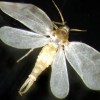 A new addition on the list of whitefly species found in Florida, Aleurodicus rugioperculatus Martin, was originally called the gumbo limbo spiraling whitefly, but is now named the rugose spiraling whitefly. Being a fairly new species to science – identified less than a decade ago, not much information is available about this pest. It is an introduced pest, endemic to Central America, and was reported for the first time in Florida from Miami-Dade County in 2009. Since then it has become an escalating problem for homeowners, landscapers, businesses, and governmental officials throughout the southern coastal counties of Florida. Feeding by this pest not only causes stress to its host plant, but the excessive production of wax and honeydew creates an enormous nuisance in infested areas. The presence of honeydew results in the growth of fungi called sooty mold, which then turns everything in the vicinity covered with honeydew black with mold. This 5-page fact sheet was written by Vivek Kumar, Cindy L. McKenzie, Catharine Mannion, Ian Stocks, Trevor Smith, and Lance S. Osborne, and published by the UF Department of Entomology and Nematology, October 2013.
A new addition on the list of whitefly species found in Florida, Aleurodicus rugioperculatus Martin, was originally called the gumbo limbo spiraling whitefly, but is now named the rugose spiraling whitefly. Being a fairly new species to science – identified less than a decade ago, not much information is available about this pest. It is an introduced pest, endemic to Central America, and was reported for the first time in Florida from Miami-Dade County in 2009. Since then it has become an escalating problem for homeowners, landscapers, businesses, and governmental officials throughout the southern coastal counties of Florida. Feeding by this pest not only causes stress to its host plant, but the excessive production of wax and honeydew creates an enormous nuisance in infested areas. The presence of honeydew results in the growth of fungi called sooty mold, which then turns everything in the vicinity covered with honeydew black with mold. This 5-page fact sheet was written by Vivek Kumar, Cindy L. McKenzie, Catharine Mannion, Ian Stocks, Trevor Smith, and Lance S. Osborne, and published by the UF Department of Entomology and Nematology, October 2013.
http://edis.ifas.ufl.edu/in1015
Tag: Vivek Kumar Jha
Swirski mite (suggested common name) Amblyseius swirskii Athias-Henriot (Arachnida: Mesostigmata: Phytoseiidae)
 Amblyseius is a beneficial predatory mite endemic to the Eastern Mediterranean region. This species is considered a generalist predator, and readily consumes small soft-bodied pest species as well as pollen or plant exudates. Amblyseius swirskii has attracted substantial interest as a biological control agent of mites, thrips and whiteflies in greenhouse and nursery crops and is currently reared and sold commercially in Europe and North America for this purpose. This 5-page fact sheet was written by Mahmut Dogramaci, Garima Kakkar, Vivek Kumar, Jianjun Chen, and Steven Arthurs, and published by the UF Department of Entomology and Nematology, June 2013.
Amblyseius is a beneficial predatory mite endemic to the Eastern Mediterranean region. This species is considered a generalist predator, and readily consumes small soft-bodied pest species as well as pollen or plant exudates. Amblyseius swirskii has attracted substantial interest as a biological control agent of mites, thrips and whiteflies in greenhouse and nursery crops and is currently reared and sold commercially in Europe and North America for this purpose. This 5-page fact sheet was written by Mahmut Dogramaci, Garima Kakkar, Vivek Kumar, Jianjun Chen, and Steven Arthurs, and published by the UF Department of Entomology and Nematology, June 2013.
http://edis.ifas.ufl.edu/in1001
EENY477/IN860 Common blossom thrips, Frankliniella schultzei Trybom (Insecta: Thysanoptera: Thripidae)
EENY477, a 6-page illustrated fact sheet by Garima Kakkar, Daksina R. Seal, and Vivek Kumar Jha, is part of the Featured Creatures collection. It describes this relatively new vegetable pest in South Florida which is a key pest in tomato and cucumber fields in South America — synonymy, distribution, description, life cycle, hosts, economic importance, and management. Includes references. Published by the UF Department of Entomology and Nematology, July 2010.
http://edis.ifas.ufl.edu/in860
EENY463/IN833 Chilli thrips Scirtothrips dorsalis Hood (Insecta: Thysanoptera: Thripidae)
EENY463, a 10-page fact sheet by Vivek Kumar Jha, Dakshina R. Seal and Garima Kakkar, is part of the Featured Creatures collection. It describes this new introduced insect pest that is an important pest of vegetable, ornamental and fruit crops — synonymy, distribution, identification, life cycle and biology, hosts, damage, disease transmission, management. Includes references. Published by the UF Department of Entomology and Nematology, November 2009.
http://edis.ifas.ufl.edu/IN833